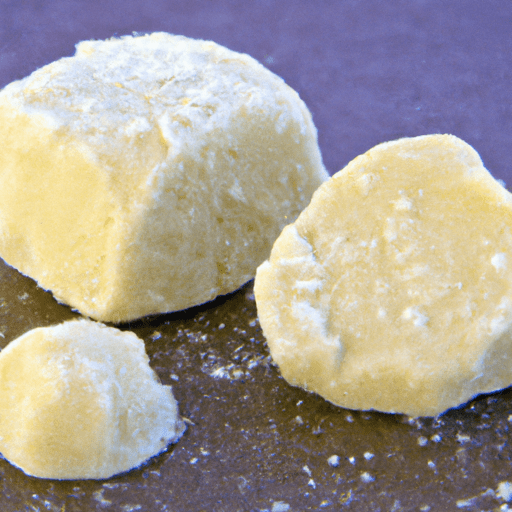The Magic of Almond Candy Dough: A Delectable Delight
Almond candy dough, also known as marzipan, is a versatile and tantalizing ingredient that adds a touch of sweetness to countless confections. With its smooth texture and nutty flavor, it has been captivating taste buds for centuries. In this blog post, we will dive into the fascinating world of almond candy dough, exploring its taste, culinary applications, nutritional value, and uncovering some intriguing historical facts.
A Taste Sensation
Almond candy dough is a blissful marriage of finely ground almonds, sugar, and a touch of liquid sweetener. The result is a soft, pliable dough that carries an intense almond aroma, enchanting your senses with its heavenly sweetness. With a taste that is both delicate and rich, it melts in your mouth, leaving behind a lingering nuttiness. Perfectly balancing sweetness and the subtle bitterness of almonds, it has a flavor that appeals to even the most discerning of palates.
Versatility at Its Finest
This remarkable ingredient offers a myriad of uses in the culinary world. It serves as an excellent filling for pastries, such as croissants, danishes, and tarts, infusing them with a delightful sweetness. Rolled thinly, it can envelop fruits, transforming them into delectable homemade marzipan treats. Almond candy dough is also widely used in cake decorating, allowing bakers to craft intricate designs and add a touch of elegance to their creations.
Nutritional Benefits
Apart from its delightful taste, almond candy dough also offers some notable nutritional benefits. Almonds, the primary ingredient, are packed with healthy fats, fiber, protein, vitamins, and minerals. These nutrient powerhouses not only provide a boost of energy but also contribute to heart health, aid in digestion, promote skin radiance, and support brain function. While almond candy dough should be enjoyed in moderation due to its sugar content, it does offer a satisfying treat that combines pleasure with nutrition.
A Fascinating Journey through History
The origins of almond candy dough can be traced back to ancient Persia, where it was considered a luxurious delicacy reserved for the elite. As trade routes expanded, this sumptuous treat spread across the globe, captivating the culinary traditions of Europe, the Middle East, and beyond. Almond candy dough became a staple in European holiday celebrations, particularly during Christmas and Easter, where it continues to be enjoyed to this day.
Fun Fact: The Marzipan City
Now, let’s uncover an intriguing fact about almond candy dough. Did you know that there is a city in Germany renowned for its marzipan? Lübeck, a charming medieval city in northern Germany, is often referred to as the “Marzipan City.” Since the 15th century, Lübeck has been producing exceptional marzipan, maintaining its reputation as one of the best marzipan producers in the world. The city even boasts an annual marzipan festival, where master confectioners showcase their artistic marzipan creations to the delight of visitors.
Embrace the Delight of Almond Candy Dough
Whether you indulge in almond candy dough as a stand-alone sweet treat or use it to elevate your culinary creations, it is an ingredient that never fails to delight. Its velvety texture, enchanting aroma, and captivating flavor make it a valuable addition to any baker’s pantry. So, go ahead and explore the endless possibilities of almond candy dough. Let your imagination run wild and savor the magic it brings to your kitchen creations.
Almond Candy Dough
Origin: Almond candy dough, also known as marzipan, has a rich history that dates back to ancient times. It is believed to have originated in the Middle East, specifically in Persia (modern-day Iran) during the 8th century. The recipe then spread throughout the Arab world and eventually reached Europe during the Crusades.
Common Uses: Almond candy dough is widely used in the culinary world. It is often shaped into various decorative forms and used to create candies, pastries, and desserts. Some popular traditional confections that feature almond candy dough include marzipan fruits, marzipan-filled chocolates, and marzipan-covered cakes. It is also used in some festive holiday treats like marzipan stollen and marzipan-filled cookies.
Nutritional Benefits: Almond candy dough is primarily made from almonds, which offer numerous nutritional benefits. Almonds are a good source of healthy fats, protein, fiber, vitamin E, and minerals such as magnesium and calcium. They also contain antioxidants. However, it’s worth noting that marzipan often contains added sugar, which can affect its overall nutritional profile.
Unique Properties: Almond candy dough has some unique properties that make it versatile in the kitchen. It can be easily molded into different shapes, making it a popular choice for creating intricate decorations. Almond candy dough also has a smooth and slightly chewy texture, and it possesses a distinct sweet flavor with a hint of almond.
Historical Significance: Throughout history, almond candy dough has been associated with various cultural and religious traditions. It has been used in celebrations and festivals, such as weddings, Christmas, and Easter. In certain cultures, marzipan plays a symbolic role, representing abundance, prosperity, or good luck. Additionally, marzipan has appeared in famous works of art, literature, and even in fictional stories like “The Nutcracker” ballet.




Use the share button below if you liked it.
It makes me smile, when I see it.